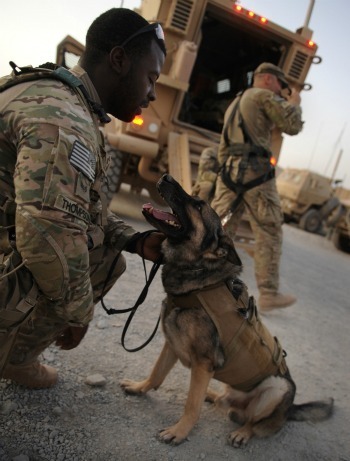Rebecca's War Dog of the Week: The BS Behind the Rats and Robot Rumors

By Rebecca Frankel
Best Defense Canine
Correspondent
Barking up the Wrong Tree (I): No,
Computers Won't Replace Human Handlers
In January, Wired ran a post that got my MWD-lovin' leash in twist. Word of it ricocheted around the Internet, prompting at least one seriously
inaccurate follow-up, and
riled up some spicy criticism among MWD handlers. The post, titled
"Army's Automated Dog Whisperer Will Train Puppies of War," draws attention to
three small-business contracts awarded by the Army to develop a technology
called Rugged Automated Training System (RATS).
Certainly news of the RATS -- specifically,
its goal to produce "a machine
that will reliably train small animals to detect explosives ... and provide an
objective unbiased measurement of the animal's sensitivity and accuracy" -- is
fascinating, as is the Army's interest in pursuing it.
The problem with the Wired post is that it misappropriates
language from the unclassified descriptions of
these contracts and relates it to canines, wrongly implying (nay, proclaiming
with its title), that the eventual success of RATS will transform the way MWDs
are trained. The post's author, reporter Katie Drummond, never qualifies or specifies the canine component in these three
contracts or the still-developing U.S. RATS program.
That's probably because
there isn't one.
"It's
completely a rat program," said Dr. Micheline Strand, chief of the Army
Research Office division funding the RATS research and manager of the program.
Dr. Strand, speaking from her North Carolina office this week, told me that
even while the Army is interested in exploring the detection capability of rats
they "are not meant to replace dogs in any way."
[[BREAK]]
Rats and
mice have piqued the interest of stateside researchers with reports of their successful
landmine and explosive detection abilities in Africa, Israel, and more recently, Colombia. Much of the appeal of these
rodents is how unlike canines they
are -- smaller, lighter, and without the emotional connection to their human
counterparts. It's also widely assumed that with the advent of RATS, training
these more diminutive mammals would be faster and less expensive, in part
because the human role could be minimized with rats. (Minimized, but not
eliminated as Drummond surmises in her post.)
But
all of the hype around RATS (and rats, respectively) is tentative and the
scientific investigation is in the early stages. Even if these RATS contracts produce results that
satisfy the Army's highest expectations, the technology is at minimum two years
away from even being produced.
"Right now it's very, very basic
research," Dr. Strand said. The Army Research Office focuses more on exploratory,
long-term research. "It's looking at 'Can we do this?'" she explained. When it
comes to RATS, "We might say, 'You know, this didn't work.'"
The
teams currently working on RATS technology are still in Phase I of their
research and the details that make each pursuit unique are being kept under
wraps. I spoke with a representative from
each of the three teams and they all assured me that this technology is not
being developed with canines in mind, even if they speculated it would be
possible someday. In part, the objective with RATS is simply to determine,
through hard data, whether a rat's capability for scent detection is even on
par with that of a dog's.
To be fair then, we can't take
canines out of the RATS equation entirely. As Dr. Strand put it, "Dogs are a
proof of concept that an animal system is actually very, very good at finding
smells. Dogs show it can be done."
And MWDs -- when matched with
their handlers -- do it better than anything
else the military has yet conceived of in the
way of IED detection. Even if RATS is
successful and even if years from
now, the Army finds a way to apply it to canines -- something I have a difficult
time envisioning -- I still don't believe it could ever replace, let alone
surpass the effectiveness of the handler-canine working bond.
William
Gressick, the principal investigator on RATS working for Barron Associates,
Inc. in Charlottesville, VA spoke with full confidence about the work he was
doing with rats, but acknowledged the integral role the dog-handler bond plays
in MWD training. "It seems very unlikely to me that, using a computer, you
could reliably train a dog to achieve the performance that a handler does. We
can't speculate on what the future will hold, but right now I can't see
that."
A final note: This post is the
first in a series devoted to upending the more egregious misperceptions currently
circulating about MWDs. If you have a question or know of a related issue that
might be addressed (or debunked) here, let us know. I'll do my best to provide
answers and bring in other experts in the field whenever possible. (The series
title comes courtesy of the talented Mr. Ricks.)
Rebecca Frankel, on leave from her FP desk, is currently
working on a book about military working dogs.
Thomas E. Ricks's Blog
- Thomas E. Ricks's profile
- 436 followers



